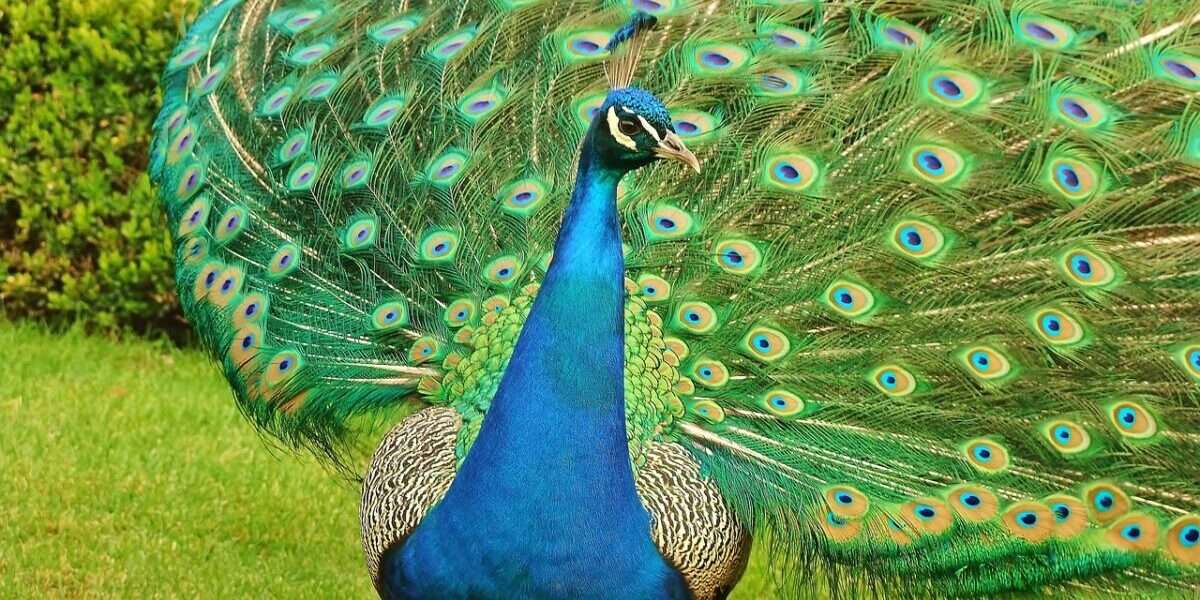The Symbolism of the Peacock in Hinduism


A majestic peacock, revered for its symbolism in Hinduism as a representation of beauty and spirituality.
The peacock, with its resplendent beauty and captivating charm, holds deep symbolic significance in Hinduism. In this ancient religion, symbols play a crucial role in conveying profound meanings and representing various aspects of divine existence.
The peacock, with its vivid colors and graceful demeanor, embodies several symbolic associations, particularly in relation to deities and goddesses. Let us explore the profound symbolism of the peacock in Hinduism and understand its significance in this rich cultural tapestry.
Significance of Animals in Hinduism
Animals have always held a prominent place in Hindu mythology, serving as important symbols. Hindu scriptures and religious texts often utilize animal symbolism to convey spiritual and philosophical concepts. These symbols provide devotees with a tangible connection to the divine and facilitate a deeper understanding of profound truths.
Introduction to the Peacock
The peacock, scientifically known as Pavo cristatus, is a large and majestic bird native to the Indian subcontinent. It is renowned for its striking appearance, characterized by vibrant and iridescent feathers, which display a mesmerizing combination of blues, greens, and purples. Peacocks are commonly found in forests, gardens, and rural areas, and they have been cherished for centuries due to their captivating beauty.
The Peacock as a Symbol in Hinduism
In Hinduism, the peacock holds significant symbolic value and is associated with various deities and goddesses. Its striking appearance and distinctive features have made it a favored emblem in Hindu art, literature, and religious ceremonies.
One of the prominent connections between the peacock and Hindu mythology is with Lord Krishna, an incarnation of Lord Vishnu. Lord Krishna is often depicted wearing a peacock feather in his hair, which holds deep symbolic meaning. The peacock feather represents the divine playfulness and charm of Lord Krishna, captivating the hearts of devotees and symbolizing his spiritual presence.
Goddess Saraswati, the Hindu deity of knowledge, music, and art, is also associated with the peacock. The peacock serves as her mount, symbolizing her connection with beauty, creativity, and wisdom. This association signifies the harmony between aesthetics and intellect, highlighting the belief that true knowledge encompasses both material and spiritual aspects.
Peacock Symbolism in Hindu Art and Architecture
The peacock’s symbolism extends beyond mythology and permeates Hindu art and architecture. Temples and palaces often feature intricate carvings and sculptures of peacocks, adorning the walls and facades with their graceful presence. These artistic representations not only enhance the aesthetic appeal but also imbue the sacred spaces with divine energy, reflecting the reverence for this magnificent bird.
Symbolic Meanings Associated with the Peacock
The peacock embodies various symbolic meanings in Hinduism. Its exquisite beauty, captivating feathers, and elegant demeanor symbolize purity, grace, and elegance. The vibrant colors of its plumage represent the vibrant and diverse aspects of creation, highlighting the intricate tapestry of life.
The peacock’s ability to display its feathers in a breathtaking fan-like pattern is seen as a symbol of spiritual awakening and enlightenment. Just as the peacock reveals its full splendor, individuals are encouraged to explore their inner selves and manifest their true potential.
In addition, the peacock’s ability to shed and regrow its feathers is associated with the concepts of immortality and resurrection. This attribute serves as a reminder that life is a continuous cycle of birth, death, and rebirth, and that spiritual transformation is an ongoing process.
Peacock Symbolism in Hindu Festivals
The symbolism of the peacock finds expression in various Hindu festivals and religious ceremonies. During auspicious occasions and celebrations, peacock motifs adorn homes, temples, and public spaces. These vibrant representations serve as reminders of the divine presence, invoking blessings, and fostering a sense of joy and spiritual connection.
The Peacock in Indian Folklore and Literature
The symbolism of the peacock extends beyond religious contexts and permeates Indian folklore and literature. Ancient texts and epics, such as the Mahabharata and the Ramayana, feature stories and legends that incorporate peacocks. These tales often highlight the bird’s beauty, regal demeanor, and association with divinity, weaving the peacock’s symbolism into the cultural fabric of the land.
Peacock Conservation Efforts in India
Recognizing the cultural and ecological significance of peacocks, conservation efforts have been initiated in India to protect these magnificent birds and their natural habitats.
Conservation organizations, along with governmental initiatives, strive to ensure the preservation of peacock populations and promote environmental awareness among the people. Preserving the peacock’s habitat not only safeguards their existence but also preserves the rich symbolism associated with them.
Conclusion
The symbolism of the peacock in Hinduism is profound and multifaceted. From its association with deities and goddesses to its representation of divine qualities, the peacock holds a special place in the hearts and minds of Hindus. Its beauty, grace, and symbolic significance continue to inspire devotees and foster a deeper understanding of the spiritual realm.
FAQs about symbolism of the peacock in Hinduism
Is the peacock considered a sacred bird in Hinduism?
Yes, the peacock is considered a sacred bird in Hinduism. It is associated with various deities and holds symbolic significance in Hindu mythology.
What does the peacock feather represent in Hinduism?
The peacock feather represents the divine playfulness and charm of Lord Krishna, symbolizing his spiritual presence and captivating the hearts of devotees.
Why is the peacock associated with Goddess Saraswati?
The peacock is associated with Goddess Saraswati, as it serves as her mount. This association signifies the connection between beauty, creativity, and wisdom.
Are there any efforts to protect peacocks in India?
Yes, several conservation efforts have been initiated in India to protect peacocks and their natural habitats, ensuring the preservation of their cultural and ecological significance.
How does the peacock symbolize spiritual awakening?
The peacock’s ability to display its feathers in a breathtaking fan-like pattern is seen as a symbol of spiritual awakening and enlightenment, encouraging individuals to explore their inner selves and manifest their true potential.
Further reading
Significance of Peacock Feather in Hinduism: https://www.sanskritimagazine.com/significance-of-peacock-feather-in-hinduism/
Symbolism Of Peacock Feather In Hinduism: https://www.boldsky.com/yoga-spirituality/faith-mysticism/2015/symbolism-of-peacock-feather-in-hinduism-059312.html
The Symbolism of the Peacock in Hinduism: https://hindumystic.wordpress.com/2017/09/29/the-symbolism-of-the-peacock-in-hinduism/
BIRD OF THE GODS: HOW THE PEACOCK GOT HIS FEATHERS: https://formfluent.com/blog/bird-of-the-gods-how-the-peacock-got-his-feathers
Recent Posts
5 Key Insights: The Significance of Yoga in Modern Life from a Hindu Perspective
Yoga, an ancient practice rooted deeply in the spiritual soil of Hinduism, has traversed a…
10 Transformative Reasons: The Spiritual Guide to Eating with Hands in Hinduism
Introduction In the age of fast food and instant gratification, the serene practice of eating…
10 Unbreakable Connections Between Hinduism and Environmental Sustainability: A Comprehensive Guide
Introduction Hinduism, one of the world's oldest religions, is more than a mere spiritual path;…
7 Timeless Principles of Non-Violence in Hinduism: A Comprehensive Guide
Introduction: Embracing Non-Violence in Hinduism The Profound Connection Between Non-Violence and Hinduism Non-violence, or Ahimsa,…
7 Transformative Powers of Yagya in Hinduism: A Complete Guide to Spiritual Rituals
Introduction to Yagya in Hinduism: A Spiritual Exploration Yagya, also spelled Yajna, is a profound…
The Deep-rooted Significance of Copper in Hinduism: 7 Enlightening Insights
Introduction Copper, with its gleaming reddish-brown allure, isn't just a metal to the spiritually profound…


